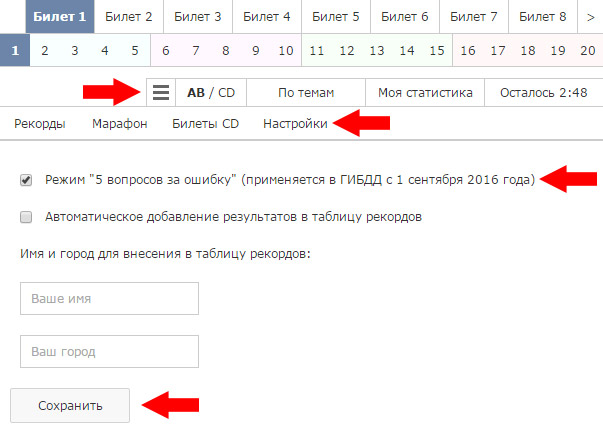The main types of limits. Online calculator. Limit solving
Let's look at illustrative examples.
Let x be a numerical variable, X the region of its variation. If each number x belonging to X is assigned a certain number y, then they say that a function is defined on the set X and write y \u003d f (x).
The set X in this case is a plane consisting of two coordinate axes - 0X and 0Y. For example, we depict the function y \u003d x 2. The axes 0X and 0Y form X - the region of its change. The figure clearly shows how the function behaves. In this case, they say that on the set X the function y \u003d x 2 is defined.
The set Y of all partial values \u200b\u200bof a function is called the set of values \u200b\u200bf (x). In other words, the set of values \u200b\u200bis the gap along the 0Y axis where the function is defined. The depicted parabola clearly shows that f (x)\u003e 0, because x2\u003e 0. Therefore, the range of values \u200b\u200bwill be. We look at many values \u200b\u200bby 0Y.
The collection of all x is called the domain of definition of f (x). We look at a lot of definitions with respect to 0X, and in our case, the range of admissible values \u200b\u200bis [-; +].
A point a (a belongs to or X) is called a limit point of the set X if in any neighborhood of a there are points of the set X other than a.
It's time to understand - what is the limit of a function?
Purely b, to which the function tends when x approaches the number a, is called function limit. It is written as follows:
For example, f (x) \u003d x 2. We need to find out what the function tends to (is not equal to) at x 2. First, we write the limit:
Let's look at the chart.
Draw a line parallel to the 0Y axis through point 2 on the 0X axis. She will cross our graph at the point (2; 4). We drop the perpendicular from this point to the 0Y axis and get to point 4. This is what our function aims at x 2. If we substitute the value 2 in the function f (x), the answer will be the same.
Now before moving on to calculation of limits, we introduce the basic definitions.
Introduced by the French mathematician Augustin Louis Cauchy in the 19th century.
Suppose that the function f (x) is defined on a certain interval in which the point x \u003d A is contained, but it is not necessary that the value f (A) be determined.
Then, according to Cauchy’s definition, function limit f (x) will be a certain number B for x, tending to A, if for each C\u003e 0 there is a number D\u003e 0 for which
Those. if the function f (x) at x A is bounded by the limit B, this is written as
Sequence limit a certain number A is called if for any arbitrarily small positive number B\u003e 0 there exists a number N such that all values \u200b\u200bin the case n\u003e N satisfy the inequality
Such a limit has the form.
A sequence that has a limit will be called convergent, if not, divergent.
As you already noticed, limits are indicated by the lim icon, under which some condition for the variable is written, and then the function itself is already written. Such a set will be read as "the limit of the function provided ...". For example:
is the limit of the function as x tends to 1.
The expression "tending to 1" means that x sequentially takes on values \u200b\u200bthat are infinitely close to 1.
Now it becomes clear that to calculate this limit, it is enough to substitute the value 1 instead of x:
In addition to a specific numerical value, x can tend to infinity. For example:
The expression x means that x is constantly increasing and infinitely close to infinity. Therefore, substituting infinity instead of x, it will become obvious that the 1-x function will tend to, but with the opposite sign:
Thus, limit calculation It comes down to finding its specific value or a specific area into which the function falls, limited by the limit.
Based on the foregoing, it follows that when calculating the limits, it is important to use several rules:
Realizing the essence of the limit and basic rules limit calculations, you’ll get a key insight into how to solve them. If what limit will cause you difficulties, then write in the comments and we will certainly help you.
Note: Jurisprudence is a science of laws that helps in conflict and other life difficulties.
Limit theory is one of the branches of mathematical analysis. The question of solving limits is quite extensive, since there are dozens of methods for solving limits of various kinds. There are dozens of nuances and tricks to solve this or that limit. Nevertheless, we still try to understand the basic types of limits that are most often encountered in practice.
Let's start with the very concept of limit. But first, a brief historical background. Once upon a time there lived in the 19th century the Frenchman Augustin Louis Cauchy, who laid the foundations of mathematical analysis and gave rigorous definitions, the definition of the limit, in particular. I must say that this same Cauchy dreamed, dreams and will dream in nightmares of all students of physics and mathematics departments, since he proved a huge number of theorems of mathematical analysis, and one theorem is more disgusting than the other. In this regard, we will not consider a strict definition of the limit, but try to do two things:
1. Understand what the limit is.
2. Learn to solve the main types of limits.
I apologize for some unscientific explanations, it is important that the material is understandable even to the teapot, which, in fact, is the task of the project.
So what is the limit?
And immediately an example of what a grandmother shreds ....
Any limit has three parts.:
1) Everyone knows the limit icon.
2) Entries under the limit icon, in this case. The record reads "X strives for unity." Most often - it is, although instead of the “X” in practice there are other variables. In practical tasks, in place of the unit, there can be absolutely any number, as well as infinity ().
3) Functions under the limit sign, in this case.
Record itself ![]() reads as follows: "the limit of function with x tending to unity."
reads as follows: "the limit of function with x tending to unity."
Let us examine the following important question - what does the expression “X” mean? seeks to unity? And what is “striving” for?
The concept of limit is a concept, so to speak, dynamic. Build the sequence: first, then,, ..., ![]() , ….
, ….
That is, the expression "x seeks to unity "should be understood as follows -" x "sequentially takes on values, which are infinitely close to unity and practically coincide with it.
How to solve the above example? Based on the foregoing, you just need to substitute the unit in the function under the limit sign:
So, the first rule: When any limit is given, first we just try to substitute a number in the function.
We considered the simplest limit, but such are found in practice, moreover, not so rarely!
Example with infinity:
We understand what is? This is the case when it grows unlimitedly, that is: first, then, then, then and so on to infinity.
And what happens to the function at this time?
, , ![]() , …
, …
So: if, then the function tends to minus infinity:
![]()
Roughly speaking, according to our first rule, we substitute infinity for the function “x” and get the answer.
Another example with infinity:
![]()
Again, we begin to increase to infinity, and look at the behavior of the function: 
Conclusion: when the function increases unlimitedly:![]()
And a series of examples:
Please try to independently analyze the following and remember the simplest types of limits:
, , , , ![]() , , , ,
, , , , ![]() ,
,
If there is any doubt somewhere, then you can pick up a calculator and practice a little.
In that case, try to build a sequence,,. If, then,,.
Note: strictly speaking, such an approach with constructing sequences of several numbers is incorrect, but it is quite suitable for understanding the simplest examples.
Also pay attention to the following thing. Even if a limit is given with a large number at the top, and even with a million:, then anyway ![]() , since sooner or later “X” will take such gigantic values \u200b\u200bthat a million compared to them will be a real microbe.
, since sooner or later “X” will take such gigantic values \u200b\u200bthat a million compared to them will be a real microbe.
What you need to remember and understand from the above?
1) When any limit is given, first we just try to substitute a number in the function.
2) You must understand and immediately decide the simplest limits, such as ![]() , , etc.
, , etc.
Now we consider the group of limits when, and the function is a fraction, in the numerator and denominator of which are polynomials
Example:
Calculate limit ![]()
According to our rule, we will try to substitute infinity into a function. What do we get above? Infinity. And what happens below? Also infinity. Thus, we have the so-called species uncertainty. One would think that the answer is ready, but in the general case this is not at all the case, and some solution must be applied, which we will now consider.
How to solve the limits of this type?
First, we look at the numerator and find to a higher degree: 
The highest degree in the numerator is two.
Now we look at the denominator and also find to the highest degree: 
The highest degree of the denominator is two.
Then we select the oldest degree of the numerator and denominator: in this example, they coincide and are equal to two.
So, the solution method is as follows: in order to reveal the uncertainty, it is necessary to divide the numerator and the denominator by the highest degree.
![]()

Here it is, the answer, and not infinity at all.
What is fundamentally important in designing a solution?
First, indicate uncertainty, if any.
Secondly, it is advisable to interrupt the decision for intermediate explanations. I usually use a sign, it does not have any mathematical meaning, but means that the decision is interrupted for an intermediate explanation.
Thirdly, in the limit, it is desirable to mark what and where it seeks. When the work is completed by hand, it is more convenient to do so: 
For notes it is better to use a simple pencil.
Of course, you can do nothing of this, but then, perhaps, the teacher will notice the flaws in the decision or start to ask additional questions on the assignment. Do you need it?
Example 2
Find limit ![]()
Again in the numerator and denominator we find to a higher degree: ![]()
The maximum degree in the numerator: 3
The maximum degree in the denominator: 4
Choose the greatest value, in this case four.
According to our algorithm, to disclose the uncertainty, we divide the numerator and denominator by.
The full design of the task may look like this:
![]()
Divide the numerator and denominator by

Example 3
Find limit ![]()
The maximum degree of "X" in the numerator: 2
The maximum degree of “x” in the denominator: 1 (can be written as)
To uncover uncertainty, it is necessary to divide the numerator and denominator by. A clean solution might look like this:
![]()
Divide the numerator and denominator by

A record means not division by zero (you cannot divide by zero), but division by an infinitely small number.
Thus, when disclosing the uncertainty of the species, we can get finite number, zero or infinity.
Limits with type uncertainty and a method for solving them
The following group of limits is somewhat similar to the limits just considered: polynomials are in the numerator and denominator, but the “X” is no longer tending to infinity, but to final number.
Example 4
Decide the limit ![]()
First, try to substitute -1 in the fraction: ![]()
In this case, the so-called uncertainty is obtained.
General rule: if the numerator and denominator contain polynomials, and there are uncertainties of the form, then for its disclosure you need to factor the numerator and denominator.
To do this, most often you need to solve the quadratic equation and (or) use the formulas of abbreviated multiplication. If these things are forgotten, then visit the page Mathematical formulas and tables and read the teaching material Hot math school course formulas. By the way, it is best to print it, it is required very often, and information from paper is better absorbed.
So, we decide our limit ![]()
Factor the numerator and denominator
In order to factor the numerator, you need to solve the quadratic equation: ![]()
First we find the discriminant:
And the square root of it:.
If the discriminant is large, for example 361, we use a calculator, the square root extraction function is on the simplest calculator.
! If the root is not extracted completely (it turns out a fractional number with a comma), it is very likely that the discriminant was calculated incorrectly or in the typo task.
Next we find the roots: ![]()
![]()
Thus:
Everything. The numerator is factorized.
Denominator. The denominator is already the simplest factor, and it cannot be simplified in any way.
![]()
Obviously, this can be reduced by:
![]()
Now we substitute -1 into the expression that remains under the limit sign:
Naturally, in the test, in the test, in the exam, the decision is never described in such detail. In the final version, the design should look something like this:
![]()
Factor the numerator. ![]()
![]()
![]()
Example 5
Calculate limit ![]()
First, the “finish" solution
![]()
Factor the numerator and denominator.
Numerator:
Denominator: ![]()
![]()
![]() ,
, ![]()

What is important in this example?
First of all, you should have a good understanding of how the numerator is disclosed, first we put 2 out of the bracket, and then used the formula of the difference of squares. This formula needs to be known and seen.
Type and species uncertainties are the most common uncertainties that need to be disclosed when solving limits.
Most of the tasks to the limits that come across students, just carry such uncertainties. For their disclosure or, more precisely, avoiding uncertainties, there are several artificial techniques for transforming the type of expression under the limit sign. These methods are as follows: the division of the numerator and denominator by the highest degree of the variable, multiplication by the conjugate expression and factorization for subsequent reduction using solutions of quadratic equations and formulas of abbreviated multiplication.
Species uncertainty
Example 1
n is equal to 2. Therefore, divide the numerator and the denominator by:
 .
.
Comment on the right side of the expression. Arrows and numbers indicate what the fraction seeks after substitution instead of n infinity values. Here, as in example 2, the degree n there is more in the denominator than in the numerator, as a result of which the whole fraction tends to an infinitesimal value or "super small number".
We get the answer: the limit of this function for a variable tending to infinity is equal.
Example 2 .
Decision. Here is the highest degree x equals 1. Therefore, we divide terminately the numerator and denominator by x:
Commentary on the course of the decision. In the numerator, we drive the “X” under the root of the third degree, and so that its initial degree (1) remains unchanged, assign it the same degree as the root, that is 3. The shooter and additional numbers are no longer in this record, so try mentally, but by analogy with the previous example, to determine what expressions in the numerator and denominator tend to after substituting infinity instead of "x".
We got the answer: the limit of this function for a variable tending to infinity is zero.
Species uncertainty
Example 3Uncover uncertainty and find the limit.
Decision. In the numerator is the difference of cubes. We decompose it into factors, using the formula of abbreviated multiplication from the course of school mathematics:
In the denominator is the quadratic trinomial, which we factor by solving the quadratic equation (once again, reference to the solution of quadratic equations):

We write down the expression obtained as a result of the transformations and find the limit of the function:

Example 4 Uncover uncertainty and find the limit
![]()
Decision. The quotient limit theorem is not applicable here, since
![]()
Therefore, we transform the fraction identically: multiplying the numerator and denominator by the binomial conjugate to the denominator, and reduce by x +1 According to the corollary of Theorem 1, we obtain an expression, solving which, we find the desired limit:

Example 5 Uncover uncertainty and find the limit
Decision. Direct Substitution x \u003d 0 into a given function leads to an uncertainty of the form 0/0. To reveal it, we perform the identical transformations and get the desired limit as a result: 
Example 6 Calculate ![]()
Decision: we use the limit theorems
Answer: 11
Example 7 Calculate ![]()
Decision: in this example, the limits of the numerator and denominator for are 0:
; ![]() . Therefore, we obtained the theorem on the limit of the quotient cannot be applied.
. Therefore, we obtained the theorem on the limit of the quotient cannot be applied.
We decompose the numerator and denominator into factors to reduce the fraction by a common factor tending to zero, and, therefore, make it possible to apply Theorem 3.
We decompose the square trinomial in the numerator according to the formula, where x 1 and x 2 are the roots of the trinomial. By factoring and the denominator, we reduce the fraction by (x-2), then we apply Theorem 3.
Answer:
Example 8 Calculate
Decision: When the numerator and denominator tend to infinity, therefore, when applying Theorem 3 directly, we get an expression that represents uncertainty. To get rid of the uncertainties of this kind, the numerator and denominator should be divided into the highest degree of the argument. In this example, you need to divide by x:

Answer:
Example 9 Calculate ![]()
Decision: x 3:

Answer: 2
Example 10 Calculate ![]()
Decision: When the numerator and denominator tend to infinity. Divide the numerator and denominator by the highest degree of the argument, i.e. x 5:
 =
= 
the numerator of the fraction tends to 1, the denominator to 0, so the fraction tends to infinity.
Answer:
Example 11 Calculate
Decision: When the numerator and denominator tend to infinity. Divide the numerator and denominator by the highest degree of the argument, i.e. x 7:

Answer: 0
Derivative.
The derivative of the function y \u003d f (x) with respect to the argument xthe limit of the ratio of its increment y to the increment x of the argument x is called when the increment of the argument tends to zero:. If this limit is finite, then the function y \u003d f (x)is called differentiable at the point x. If this limit exists, then they say that the function y \u003d f (x) has an infinite derivative at x.
Derivatives of basic elementary functions:
1. (const) \u003d 09.
3. 11. ![]()
4. ![]() 12.
12. ![]()
5. 13. ![]()
6. ![]() 14.
14. ![]()
Differentiation rules:
a) ![]()
in) ![]()
Example 1 Find the Derived Function ![]()
Decision: If we find the derivative of the second term according to the fraction differentiation rule, then the first term is a complex function, the derivative of which is found by the formula:
Where then

When solving, the formulas were used: 1,2,10, a, c, d.
Answer:
Example 21 Find the Derived Function ![]()
Decision: both terms are complex functions, where for the first,, and for the second,, then
Answer: ![]()
Derivative Applications.
1. Speed \u200b\u200band acceleration
Let the function s (t) describe position object in some coordinate system at time t. Then the first derivative of the function s (t) is instantaneous speed object:
v \u003d s ′ \u003d f ′ (t)
The second derivative of the function s (t) is the instantaneous acceleration object:
w \u003d v ′ \u003d s ′ ′ \u003d f ′ ′ (t)
2. Tangent equation
y − y0 \u003d f ′ (x0) (x − x0),
where (x0, y0) are the coordinates of the tangent point, f ′ (x0) is the value of the derivative of the function f (x) at the tangent point.

3. Normal equation
y − y0 \u003d −1f ′ (x0) (x − x0),
where (x0, y0) are the coordinates of the point at which the normal is drawn, f ′ (x0) is the value of the derivative of the function f (x) at a given point.
4. Function increase and decrease
If f (x0)\u003e 0, then the function increases at the point x0. In the figure below, the function is increasing at x
If f (x0)<0, то функция убывает в точке x0 (интервал x1

5. Local function extremes
The function f (x) has local maximum at x1 if there exists a neighborhood of x1 such that f (x1) ≥f (x) for all x from this neighborhood.
Similarly, the function f (x) has local minimum at x2 if there exists a neighborhood of x2 such that f (x2) ≤f (x) for all x from this neighborhood.
6. Critical points
Point x0 is critical point function f (x) if the derivative f ′ (x0) in it is equal to zero or does not exist.
7. The first sufficient sign of the existence of an extremum
If the function f (x) increases (f ′ (x)\u003e 0) for all x in a certain interval (a, x1] and decreases (f ′ (x)<0) для всех x в интервале и возрастает (f′(x)>0) for all x from the interval)





